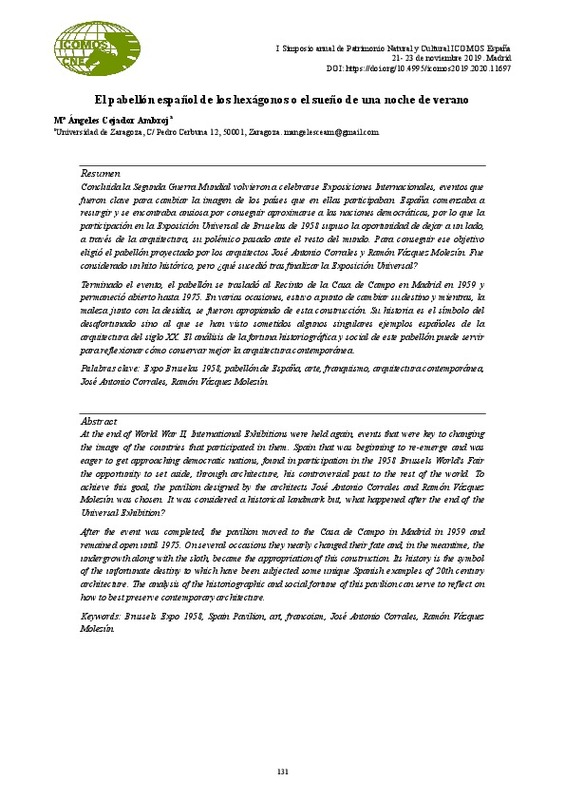JavaScript is disabled for your browser. Some features of this site may not work without it.
Buscar en RiuNet
Listar
Mi cuenta
Estadísticas
Ayuda RiuNet
Admin. UPV
El pabellón español de los Hexágonos o el sueño de una noche de verano
Mostrar el registro sencillo del ítem
Ficheros en el ítem
| dc.contributor.author | Cejador Ambroj, Mª Ángeles
|
es_ES |
| dc.coverage.spatial | east=-3.7421015; north=40.4126577; name=Pabellón de los hexágonos, Madrid, Espanya | es_ES |
| dc.date.accessioned | 2021-01-28T09:08:08Z | |
| dc.date.available | 2021-01-28T09:08:08Z | |
| dc.date.issued | 2021-01-21 | |
| dc.identifier.isbn | 9788490488263 | |
| dc.identifier.uri | http://hdl.handle.net/10251/160137 | |
| dc.description.abstract | [EN] At the end of World War II, International Exhibitions were held again, events that were key to changing the image of the countries that participated in them. Spain that was beginning to re-emerge and was eager to get approaching democratic nations, found in participation in the 1958 Brussels World's Fair the opportunity to set aside, through architecture, his controversial past to the rest of the world. To achieve this goal, the pavilion designed by the architects José Antonio Corrales and Ramón Vázquez Molezún was chosen. It was considered a historical landmark but, what happened after the end of the Universal Exhibition? After the event was completed, the pavilion moved to the Casa de Campo in Madrid in 1959 and remained open until 1975. On several occasions they nearly changed their fate and, in the meantime, the undergrowth along with the sloth, became the appropriation of this construction. Its history is the symbol of the unfortunate destiny to which have been subjected some unique Spanish examples of 20th century architecture. The analysis of the historiographic and social fortune of this pavilion can serve to reflect on how to best preserve contemporary architecture. | es_ES |
| dc.description.abstract | [ES] Concluida la Segunda Guerra Mundial volvieron a celebrarse Exposiciones Internacionales, eventos que fueron clave para cambiar la imagen de los países que en ellas participaban. España comenzaba a resurgir y se encontraba ansiosa por conseguir aproximarse a las naciones democráticas, por lo que la participación en la Exposición Universal de Bruselas de 1958 supuso la oportunidad de dejar a un lado, a través de la arquitectura, su polémico pasado ante el resto del mundo. Para conseguir ese objetivo eligió el pabellón proyectado por los arquitectos José Antonio Corrales y Ramón Vázquez Molezún. Fue considerado un hito histórico, pero ¿qué sucedió tras finalizar la Exposición Universal? Terminado el evento, el pabellón se trasladó al Recinto de la Casa de Campo en Madrid en 1959 y permaneció abierto hasta 1975. En varias ocasiones estuvo a punto de cambiar su destino y mientras, la maleza junto con la desidia, se fueron apropiando de esta construcción. Su historia es el símbolo del desafortunado sino al que se han visto sometidos algunos singulares ejemplos españoles de la arquitectura del siglo XX. El análisis de la fortuna historiográfica y social de este pabellón puede servir para reflexionar cómo conservar mejor la arquitectura contemporánea. | es_ES |
| dc.format.extent | 8 | es_ES |
| dc.language | Español | es_ES |
| dc.publisher | Editorial Universitat Politècnica de València | es_ES |
| dc.relation.ispartof | I Simposio anual de Patrimonio Natural y Cultural ICOMOS España | es_ES |
| dc.rights | Reserva de todos los derechos | es_ES |
| dc.subject | Patrimonio | es_ES |
| dc.subject | Tangible | es_ES |
| dc.subject | Intangible | es_ES |
| dc.subject | Paisajes Culturales | es_ES |
| dc.subject | Itinerarios | es_ES |
| dc.subject | Turismo | es_ES |
| dc.subject | Arquitectura | es_ES |
| dc.subject | Arqueología | es_ES |
| dc.subject | Pintura | es_ES |
| dc.subject | Escultura | es_ES |
| dc.subject | Arte | es_ES |
| dc.subject | Expo Bruselas 1958 | es_ES |
| dc.subject | Pabellón de España | es_ES |
| dc.subject | Franquismo | es_ES |
| dc.subject | Arquitectura contemporánea | es_ES |
| dc.subject | José Antonio Corrales | es_ES |
| dc.subject | Ramón Vázquez Molezún | es_ES |
| dc.subject | Brussels Expo 1958 | es_ES |
| dc.subject | Spain Pavilion | es_ES |
| dc.subject | Art | es_ES |
| dc.subject | Francoism | es_ES |
| dc.title | El pabellón español de los Hexágonos o el sueño de una noche de verano | es_ES |
| dc.type | Capítulo de libro | es_ES |
| dc.type | Comunicación en congreso | es_ES |
| dc.identifier.doi | 10.4995/icomos2019.2020.11697 | |
| dc.rights.accessRights | Abierto | es_ES |
| dc.description.bibliographicCitation | Cejador Ambroj, MÁ. (2021). El pabellón español de los Hexágonos o el sueño de una noche de verano. En I Simposio anual de Patrimonio Natural y Cultural ICOMOS España. Editorial Universitat Politècnica de València. 131-138. https://doi.org/10.4995/icomos2019.2020.11697 | es_ES |
| dc.description.accrualMethod | OCS | es_ES |
| dc.relation.conferencename | I Simposio anual de Patrimonio Natural y Cultural ICOMOS España | es_ES |
| dc.relation.conferencedate | Noviembre 21-23,2019 | es_ES |
| dc.relation.conferenceplace | Madrid | es_ES |
| dc.relation.publisherversion | http://ocs.editorial.upv.es/index.php/icomos_es/icomos2019/paper/view/11697 | es_ES |
| dc.description.upvformatpinicio | 131 | es_ES |
| dc.description.upvformatpfin | 138 | es_ES |
| dc.type.version | info:eu-repo/semantics/publishedVersion | es_ES |
| dc.relation.pasarela | OCS\11697 | es_ES |








